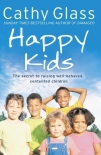Happy Kids by Cathy Glass (best autobiographies to read .txt) 📕

Read free book «Happy Kids by Cathy Glass (best autobiographies to read .txt) 📕» - read online or download for free at americanlibrarybooks.com
- Author: Cathy Glass
Read book online «Happy Kids by Cathy Glass (best autobiographies to read .txt) 📕». Author - Cathy Glass
If as a parent, care worker or teacher you have slipped into the habit of using the third person when addressing a child, I urge you to stop.
Sanctions and rewards
Rewards are given for good behaviour and sanctions imposed for bad. Both should come as soon after the behaviour that has merited the reward or sanction as possible so that the child can understand that cause equals effect.
Rewards can be verbal – praise for good behaviour – or a small treat, such as extra television or computer time, or a favourite activity. Star charts, also known as reward charts, are sometimes used to reward good behaviour and have enjoyed a recent revival in popularity. A reward chart is a large brightly coloured chart, either homemade or bought, which is displayed on a wall where the child can see it. The child is rewarded for his or her good behaviour by being allowed to add a sticker to the chart, to the praise and admiration of his parent/carer/childminder/nursery teacher. I have not used reward charts for many years and probably won’t again, because I never found them very effective in the long term. Once the novelty had worn off (which took only a week at the most) something else had to be found to regain the child’s interest and therefore his or her cooperation. However, as with the naughty chair, if you are using a reward chart and it is working, continue, until the behaviour you are trying to change has been modified. Note that the success of the reward chart relies on you remembering to add the sticker each time, and on you making it a revered achievement, i.e. something the child aspires to – ‘Well done, Claire/Tom! You have earned another sticker. Let’s go and put it on now,’ said by you ceremoniously and with much praise.
Sanctions are the loss of something a child likes or wants as a result of persistent unacceptable behaviour. Sanctions are used in the 3Rs strategy when cooperation hasn’t been achieved after you have Requested, Repeated and Reaffirmed. In the case of Claire staying in her pushchair in the supermarket, she was rewarded with your praise – ‘Good girl’ – and allowed to walk once she had left the supermarket. In the case of Tom who did not respond to your Request for him to stop running his toy lorry over the coffee table, the sanction was the loss of his lorry for a set period of time.
Sanctions need to be age and incident appropriate, and should come as soon as possible after the negative behaviour. As the 3Rs teaches cooperation, with the child doing as he or she has been asked, as you implement the 3Rs strategy the number of instances where sanctions need to be imposed will be reduced.
Foster carers are very limited in the sanctions they can apply; we can’t, for example, stop pocket money. I have found that stopping television or computer or PlayStation time is very effective, for all ages. If the child persists in his or her challenging behaviour and, after warning the child what will happen if he or she doesn’t stop the negative behaviour, I stop viewing time in ten-minute slots. This accumulates, so that ten minutes is added each time the child persistently challenges or disobeys. Ten minutes becomes twenty, then thirty, and so on, resulting in the loss of all viewing time for that evening if necessary. It is highly effective. One ten-year-old boy I fostered whose very challenging behaviour had seen off three foster carers in three weeks and who had been excluded from two schools, stopped 90 per cent of his bad behaviour in a week, simply by my using the 3Rs and the loss of television time as a sanction.
The closed choice
I like this technique immensely, as it’s easy and instant. I use it all the time to ensure cooperation as part of the 3Rs, and with all ages of children. It works with adults too! A closed choice is a clever little ploy that allows the child to believe he or she is making his or her own decision, while in effect the child is complying with what you have asked him or her to do. It is highly successful and greatly reduces confrontation, while increasing cooperation. The end result is that the child has done as you have asked without it becoming an issue.
It works like this. You want a child to do something which you think is going to be an issue, as it has been an issue in the past, so you offer two alternatives which lead to the same result – i.e. the child does as you want.
Let’s say you want Tom to clear up his toys, which are littering the entire downstairs of the house. Tom has had a great time playing, but you know from previous experience that he is less enthusiastic about clearing up and likely to refuse, ignore you or throw a wobbler. Now is a good time to use the closed choice. Instead of simply saying,‘Tom, put your toys away, please,’you say,‘Tom, it’s time to put your toys away. Which room do you want to clear up first?’Rather than refusing, Tom will find the answer (the decision as to where he wants to begin) already on his lips –‘This room first.’
Or say Claire needs to put on her shoes, because you are going out, but you know from past experience that Claire doesn’t like wearing her shoes and would rather go barefoot, as she does





Comments (0)